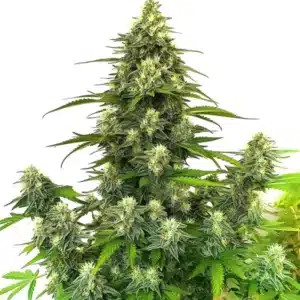Cream Candy Autoflowering Strain Description
Cream Candy Auto is a beloved cannabis strain that has captured the attention of growers and enthusiasts alike due to its delightful flavors and powerful effects. Known for its smooth blend of genetics, Cream Candy combines a sweet aroma with a relaxing experience, making it a top choice for both recreational and medicinal users.
Recommended Strains
Cream Candy Auto
 THC: 19% - 24%
THC: 19% - 24% Type of seed: Autoflowering
Type of seed: Autoflowering Phenotype: Mostly Indica
Phenotype: Mostly Indica Day to flower: 7 - 8 weeks
Day to flower: 7 - 8 weeks
This strain is a cross between three well-regarded varieties: Blue Black, Maple Leaf, and White Rhino. These genetics give it a predominantly Indica profile, resulting in short, compact plants with dense buds covered in frosty trichomes. The buds display vibrant green shades that are enhanced by a sugary coating of resin, making them visually appealing and potent.
The aroma of Cream Candy is dominated by earthy sweetness, with subtle hints of floral and herbal undertones. The flavor is similarly delightful, offering a rich combination of earthy notes paired with sweetness that lingers on the palate. This flavor profile contributes to a memorable experience, whether smoked or vaporized.
Promos & Deals
Environmental Requirements for Growing Cream Candy Autoflowering
Creating the perfect environment for your Cream Candy Autoflowering plants is crucial for achieving the best possible yield and quality. This strain thrives in temperate conditions, with day temperatures ideally between 70-80°F (21-27°C). During nighttime, temperatures should be slightly cooler, but not below 60°F (16°C) to ensure proper growth and bud development.
Maintaining consistent humidity levels is also essential to avoid issues like mold or mildew. During the vegetative stage, a relative humidity of 50-60% is ideal, while flowering requires a lower humidity level of around 40-50% to prevent bud rot. Providing optimal air circulation is key to avoiding these common issues and ensuring healthy growth.
When growing Cream Candy indoors, use high-quality LED grow lights or HPS lamps to deliver the necessary light intensity. This strain responds well to 18-20 hours of light per day during the vegetative stage, followed by 12 hours of light and 12 hours of uninterrupted darkness during flowering. Outdoor growers should ensure a sunny location with plenty of direct sunlight to maximize growth and yield.
Setting Up The Growing Space for Cannabis
Indoor Cannabis Cultivation
For indoor cultivation, a suitable grow tent or room is essential. Make sure your grow space has enough height for the plants to develop fully, along with proper ventilation to maintain a stable climate. Installing an efficient exhaust system with a carbon filter helps control odor and keep the air fresh. Reflective materials such as Mylar sheets can be used to enhance light efficiency.
Cream Candy Autoflowering can be grown in a variety of growing mediums, from soil to hydroponic systems. For soil growers, choose high-quality soil with good drainage and a pH level between 6.0-6.5. Hydroponic systems offer faster growth, but require careful monitoring of pH and nutrient levels. Keeping conditions stable is key to preventing stress and promoting vigorous growth.
Outdoor Cannabis Cultivation
When growing outdoors, select a location that receives ample sunlight throughout the day. Cream Candy Autoflowering is relatively compact, reaching heights of around 3.28 feet (1 meter), making it suitable for smaller outdoor gardens. Using large containers or fabric pots allows for better control over the soil environment and helps keep the roots healthy.
Protecting your plants from wind is also recommended, as strong gusts can damage branches or hinder growth. Using stakes or trellises can support the branches as the buds develop, preventing them from snapping under the weight of the flowers. Good airflow is essential for preventing mold and ensuring a healthy harvest.

Propagation and Germination of Cream Candy Strain
Starting your Cream Candy Autoflowering seeds properly is the first step toward a successful harvest. To germinate the seeds, soak them in distilled water or place them in a damp paper towel for 24-48 hours. Keep them in a dark, warm space at a temperature of 70-85°F (21-29°C) during this time.
Once the seeds have sprouted and developed small taproots, carefully transfer them to a light, well-draining soil mix or a suitable hydroponic medium. Maintain a humidity level of 60-70% during the early seedling stage and provide indirect light until the seedlings develop their first set of true leaves.
As the seedlings mature, gradually increase the light intensity, ensuring they receive 18-20 hours of light each day during the vegetative stage. By providing a stable environment with appropriate lighting and humidity, you can ensure a high germination rate and healthy young plants ready for transplantation.
Vegetative Phase of Cream Candy Autoflowering
During the vegetative phase, Cream Candy Autoflowering plants focus on developing their structure and foliage. Providing sufficient light 18-20 hours per day is essential for promoting vigorous growth. High-quality LED grow lights or HPS lamps are ideal for delivering the correct light spectrum during this stage.
Using a nutrient-rich fertilizer with a higher nitrogen content will help support leaf and stem development. Monitor your plants closely for signs of deficiencies or nutrient burn, and adjust the feeding schedule accordingly. Watering should be done when the top inch of soil feels dry, but avoid overwatering to prevent root rot.
Consider implementing low-stress training (LST) techniques to encourage an even canopy and improve light penetration to all parts of the plant. Pruning lower branches that receive little light helps focus energy on the main buds and improves airflow within the canopy.
Flowering Phase of Cream Candy Auto
The flowering phase is when Candy Cream Strain Autoflower truly shines, producing dense buds with a rich coating of trichomes. Switch the light cycle to 12 hours of light and 12 hours of darkness to initiate flowering. During this stage, reduce humidity to 40-50% to prevent mold issues and maintain a temperature between 65-75°F (18-24°C).
Feeding your plants with a bloom-specific nutrient formula, which is higher in phosphorus and potassium, will support healthy bud development. Keep an eye on the trichomes using a magnifying tool to determine the optimal time to harvest typically when they turn a milky white with some amber coloration.
As the buds develop, use stakes or trellises to provide additional support to the branches, as the weight of the flowers can cause them to bend or break.
Cannabis Fertilization and Nutrition
Proper nutrition is essential for maximizing the yield and potency of Cream Candy Autoflowering. During the vegetative phase, a nitrogen-rich fertilizer should be used, while flowering calls for nutrients higher in phosphorus and potassium.
Consider adding beneficial supplements, such as bloom boosters or beneficial microbes, to further enhance the plant’s growth. Flush the plants with pure water during the last two weeks of flowering to remove any nutrient residues that could affect the flavor of the final product.
Pest And Disease Control for Cannabis Growing
Cream Candy Autoflowering is generally resistant to pests and diseases, but preventive measures are still important. Regularly inspect your plants for pests such as spider mites or aphids, and maintain a clean grow space to minimize the risk of infestations. Introducing beneficial insects like ladybugs can help keep pest populations under control.
To prevent fungal diseases like powdery mildew, ensure proper air circulation and keep humidity levels low during the flowering phase. If issues do arise, organic fungicides or natural remedies like neem oil can be effective solutions.
Harvesting and Curing for Cannabis Growing
Harvesting Cream Candy Autoflowering at the right time ensures maximum potency and flavor. Monitor the trichomes to determine maturity harvest when most trichomes are milky with a few turning amber. Use sterilized shears to cut the branches and hang them in a dark, well-ventilated space to dry.
Drying typically takes 7-14 days. Once the buds are dry, cure them in airtight glass jars, opening the jars daily for the first week to release excess moisture. Proper curing can take 2-4 weeks and significantly enhances the flavor and overall quality of the buds.
Tips for Drying Cannabis Buds
- Maintain the Right Temperature and Humidity: Dry your buds in a dark space with a temperature of 60-70°F (15-21°C) and humidity levels of 50-60%. This ensures a slow, even drying process that preserves terpenes and cannabinoids.
- Avoid Direct Light: Keep your drying area dark, as exposure to direct light can degrade THC and reduce the potency of your buds.
- Provide Proper Air Circulation: Use a small fan to ensure gentle air circulation in the drying space. However, avoid blowing air directly onto the buds, as this can cause uneven drying or over-drying.
- Check for Mold: Inspect the buds regularly during the drying process for any signs of mold. Proper humidity control and air circulation help mitigate the risk of mold development.
- Do Not Rush the Drying Process: Patience is key when drying cannabis. Rushing the process by increasing temperature or airflow can lead to harsh smoke and diminished flavor.

Is Cream Candy Autoflowering Indica or Sativa?
Cream Candy Autoflowering is predominantly an Indica strain. Its genetics, derived from Blue Black, Maple Leaf, and White Rhino, provide a strong Indica influence, leading to a relaxing body high that is perfect for unwinding. The effects are balanced with a touch of cerebral uplift, making it versatile for both day and nighttime use.
Advantages of Growing Cream Candy Auto
- High THC content, offering potent effects.
- Short, compact structure suitable for small grow spaces.
- Easy to grow, beginner-friendly strain.
- Delightful earthy and sweet flavor profile.
- Good resistance to pests and diseases.
Disadvantages of Growing Cream Candy Autoflowering
- Requires odor control due to strong aroma during flowering.
- Limited height may require careful training to maximize yield.
- Requires support during flowering due to heavy buds.
Similar Strains
- White Widow Autoflowering: Known for its balanced effects and resinous buds, offering a similar ease of cultivation.
- Blueberry Autoflowering: Offers sweet, fruity flavors and a relaxing effect, much like Cream Candy.
- Northern Lights Autoflowering: Another Indica-dominant strain, known for its resilience and calming effects.
Tips for Professional Growers
- Use CO2 enrichment during flowering to boost yields and enhance bud development.
- Employ advanced training techniques, such as SCROG (Screen of Green), to maximize light penetration and bud production.
- Consider using automated systems for irrigation and climate control to maintain a stable growing environment and reduce manual labor.
Why Buy Cream Candy Autoflowering Strain
Cream Candy Autoflowering is an excellent choice for those looking for a potent, easy-to-grow strain with a relaxing effect. Its high THC levels, delightful flavors, and balanced effects make it versatile for both recreational and medicinal use. Whether you’re a beginner or a seasoned grower, Cream Candy delivers a rewarding cultivation experience with a high yield of quality buds.
FAQs
What is the THC content of Cream Candy Autoflowering?
Cream Candy Autoflowering has a high THC content ranging from 19% to 24%, providing potent effects.
How long does Cream Candy Autoflowering take to flower?
The flowering time for this strain is approximately 8-10 weeks.
Is Cream Candy Autoflowering suitable for beginners?
Yes, Cream Candy Autoflowering is beginner-friendly and relatively easy to grow, making it a good choice for those new to cannabis cultivation.
What are the medical benefits of Cream Candy Auto?
This strain is known to help with conditions such as arthritis, insomnia, and pain, thanks to its relaxing Indica effects.
What flavors can I expect from Cream Candy Autoflowering?
This strain has an earthy and sweet flavor profile, with subtle floral notes that enhance the smoking experience.

















